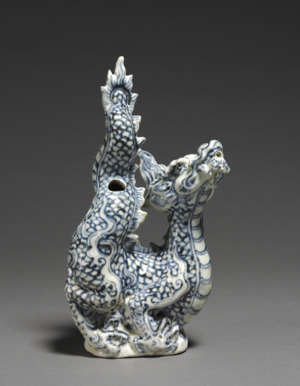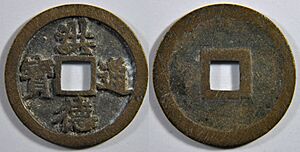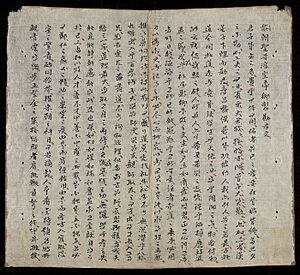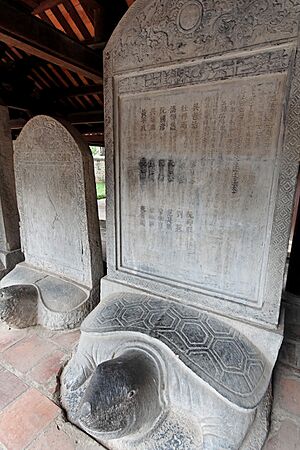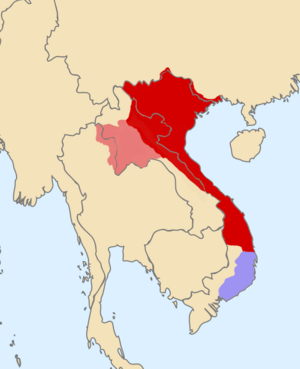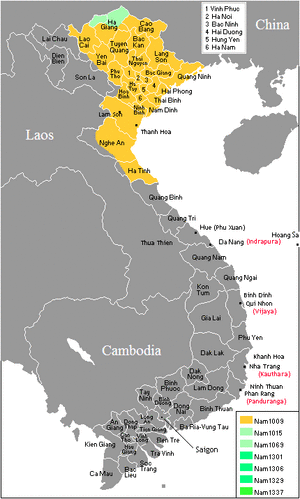Lê Thánh Tông facts for kids
Quick facts for kids Lê Thánh Tông黎聖宗 |
|||||||||||||||||
|---|---|---|---|---|---|---|---|---|---|---|---|---|---|---|---|---|---|
| Emperor of Đại Việt | |||||||||||||||||
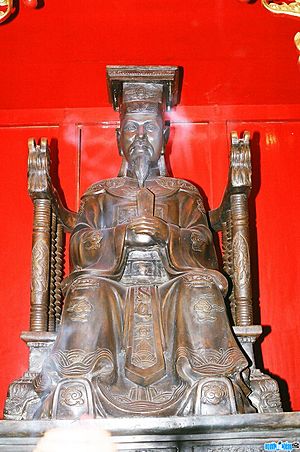 |
|||||||||||||||||
| Emperor of the Le dynasty | |||||||||||||||||
| Reign | 13 June 1460 – 13 March 1497 (36 years, 250 days) | ||||||||||||||||
| Predecessor | Lê Nghi Dân | ||||||||||||||||
| Successor | Lê Hiến Tông | ||||||||||||||||
| Born | Lê Tư Thành (黎思誠) 13 January 1442 |
||||||||||||||||
| Died | 3 March 1497 (aged 54) | ||||||||||||||||
| Burial | Chiêu Tomb, Lam Kinh, Đại Việt | ||||||||||||||||
| Spouse | Nguyễn Thị Huyên | ||||||||||||||||
| Issue |
|
||||||||||||||||
|
|||||||||||||||||
| Dynasty | Later Lê | ||||||||||||||||
| Father | Lê Thái Tông | ||||||||||||||||
| Mother | Ngô Thị Ngọc Dao | ||||||||||||||||
| Personal name | |
| Vietnamese | Lê Hạo |
|---|---|
| Hán-Nôm | 黎灝 |
| Temple name | |
| Vietnamese alphabet | Lê Thánh Tông |
|---|---|
| Hán-Nôm | 黎聖宗 |
Lê Thánh Tông (born Lê Hạo) was a powerful emperor of Đại Việt (now Vietnam). He ruled from 1460 to 1497, making him the fifth and longest-reigning emperor of the Later Lê dynasty. Many people remember him as one of Vietnam's greatest leaders. He became emperor after a sudden change in power in 1460.
His time as emperor is famous for big changes. He improved how the government worked, strengthened the army, and made education better. He also expanded Đại Việt's land to the south by winning wars against the Champa states. His rule brought a cultural shift, replacing old noble families with smart scholars. This period is often called the Prospered reign of Hồng Đức, meaning a time of great success.
Who Was Lê Thánh Tông?
Lê Thánh Tông had several names. His birth name was Lê Hạo. He was also known as Tư Thành and later took the temple name Thánh Tông. He also used other special names like Đạo Am chủ nhân and Tao Đàn nguyên súy.
His Early Life
Lê Tư Thành was born on August 25, 1442. He was the fourth son of Emperor Lê Thái Tông and his mother, Ngô Thị Ngọc Dao. A legend says his mother dreamed of a special child from the Jade Emperor before he was born.
Even as a young boy, Tư Thành was described as very gifted and intelligent. People said he had a strong, kind, and bright personality. They believed he was meant to be an emperor who would protect the nation.
When he was three, he moved to the royal palace in Đông Kinh (now Hanoi). There, he studied with his half-brother, Emperor Lê Nhân Tông, and other brothers. In 1445, he was given the title Prince of Binh Nguyen. Officials who taught him noticed how smart and dignified he was.
Becoming Emperor
In 1459, Lê Thái Tông's oldest son, Lê Nghi Dân, took power by force. He removed the reigning emperor, Lê Nhân Tông.
Nine months later, in 1460, two military leaders, Nguyễn Xí and Đinh Liệt, led a counter-attack. They successfully removed Lê Nghi Dân. These leaders were old friends and helpers of Lê Lợi, who founded the dynasty. They were highly respected.
The plotters asked Prince Tư Thành to become the new emperor, and he agreed. Two days after Lê Nghi Dân was removed, Lê Hạo was officially named Emperor. The new king gave Nguyễn Xí and Đinh Liệt important roles in his government.
His Time as Emperor
Government Improvements
Emperor Lê Thánh Tông made many changes to how the government worked. He wanted to replace the old ruling families with educated officials. These officials were chosen through special exams based on Confucian teachings.
He organized the government into six main departments, similar to the Chinese system. These departments handled things like money, ceremonies, justice, and the army. He also created a group of officials called the Board of Censors. Their job was to watch other government officials and report directly to the emperor.
In 1469, the entire country was mapped, and a full count of all villages and people was done. The country was divided into 13 provinces, each with its own governor and army commander. He ordered a new count of people every six years.
His government also worked on public projects. They built and fixed granaries (places to store grain) and repaired irrigation systems after floods. Doctors were sent to areas where people were sick. Even though he was young, he brought stability back to Đại Việt. By 1471, the government had over 5,300 officials.
By 1490, a new count showed about 8,000 villages and towns. The total population was around 3.7 million people. The Red River delta was the most crowded area in Southeast Asia at that time.
New Laws and Justice
In 1483, Lê Thánh Tông created a new set of laws for Đại Việt called the Hồng Đức Code. This code is now considered one of Vietnam's most important national treasures.
Money and Trade
During his rule, Vietnamese pottery was traded far away, even to the Middle East. However, Emperor Thánh Tông preferred that the country focus on its own economy, especially farming. He didn't encourage a lot of international trade.
In 1461, he told officials to avoid too much trade with other countries. He also made sure that weights and measures were the same everywhere. After defeating Champa in 1471, he sent many Vietnamese people to live in the newly won lands. Land was shared fairly, and officials helped people in these new areas. By the end of the 15th century, Vietnam was very prosperous.
Education and Learning
Thánh Tông wanted to spread Confucian ideas throughout the country. He ordered that temples dedicated to Confucius be built in all provinces. These temples had classic books on Confucianism. He also stopped the building of new Buddhist or Taoist temples.
His reign was a golden age for Confucian learning in Vietnam. Over 500 scholars passed the royal exams during his time. In 1460, he asked a scholar named Ngô Sĩ Liên to write an official history book. This book, called Đại Việt sử ký toàn thư, was finished in 1479.
Relations with Other Countries
Ming China
Lê Thánh Tông's rule tested Vietnam's relationship with Ming China. This happened after Vietnam defeated Champa in 1471 and invaded Laos between 1479 and 1481.
In 1472, when Vietnamese pirates attacked Chinese ships, the Ming emperor asked Thánh Tông to stop them. Đại Việt denied that its people were involved.
Emperor Lê Thánh Tông also limited contact with foreigners. Some Chinese sailors whose ships were blown off course were captured and held in Vietnam. Young Chinese men were sometimes forced to become slaves. Some historians think these Chinese were actually involved in illegal trade, and the Vietnamese government was cracking down on it.
One story tells of a young Chinese man named Wu Rui. He was captured in the 1460s and forced to become a eunuch (a palace servant) in the Vietnamese imperial palace for almost 25 years. He later escaped back to China.
Champa
In 1470, a large Cham army attacked the Vietnamese army at Huế. The local commander asked for help from Hanoi. Champa was defeated in 1471, which changed the balance of power in the region forever.
Laos and Burma
In 1448, Vietnam had already taken control of some land in what is now Laos. In 1471, Thánh Tông made this area a Vietnamese province.
In 1478, Thánh Tông decided to invade Laos. He gathered a large army. Around this time, the Laotian king, Chakkaphat, captured a rare white elephant. White elephants were symbols of kingship. Thánh Tông asked for some of the elephant's hair as a gift, but the Laotian king sent a box of dung instead. This was seen as a big insult. Also, Laos was expanding its power over local tribes that used to pay tribute to Vietnam.
So, in 1479, Thánh Tông led an army of 180,000 men into Laos. They captured the capital, Luang Phabang, and the Laotian ruler was killed. Vietnamese forces even pushed into parts of modern-day Myanmar. However, they faced strong resistance and eventually withdrew by 1484.
Other Powers and Pirates
Lê Thánh Tông also dealt with pirates. In 1470, he sent an army to fight pirates in the Gulf of Tonkin to make sea travel safe. In 1475, pirates from the Ryukyu Islands and Champa attacked a Vietnamese port.
In 1485, envoys from countries like Malacca, Java, Siam, Laos, and Champa visited Đại Việt. Lê Thánh Tông considered these countries as paying tribute to Vietnam.
As a Poet
Emperor Lê Thánh Tông was also a poet. He had a group of 28 poets recognized by his court. Some of his poems are still known today. He wrote poems about his military campaigns.
Family Life
- Father: Lê Thái Tông
- Mother: Empress Quang Thuc Ngo Thi Ngoc Dao
- Wives and Children:
- Empress Huy Gia (Empress Truong Lac) Nguyễn Thị Hằng
- Crown Prince Le Tranh, who became Emperor Lê Hiến Tông
- Empress Nhu Huy of Phung clan
- Prince Le Tan, father of Emperor Lê Tương Dực
- Imperial Consort Minh of Pham clan
- Prince Le Tung
- Princess Loi Y Lê Oánh Ngọc
- Princess Lan Minh Lê Lan Khuê
- Imperial Consort Kinh of Nguyen clan
- Princess Minh Kinh Lê Thụy Hoa
- Consort Nguyen thi
- Prince Le Thoan
- Lady Nguyen
- Lady Nguyen
- Empress Huy Gia (Empress Truong Lac) Nguyễn Thị Hằng
See also
- List of Vietnamese monarchs
- Lê dynasty



